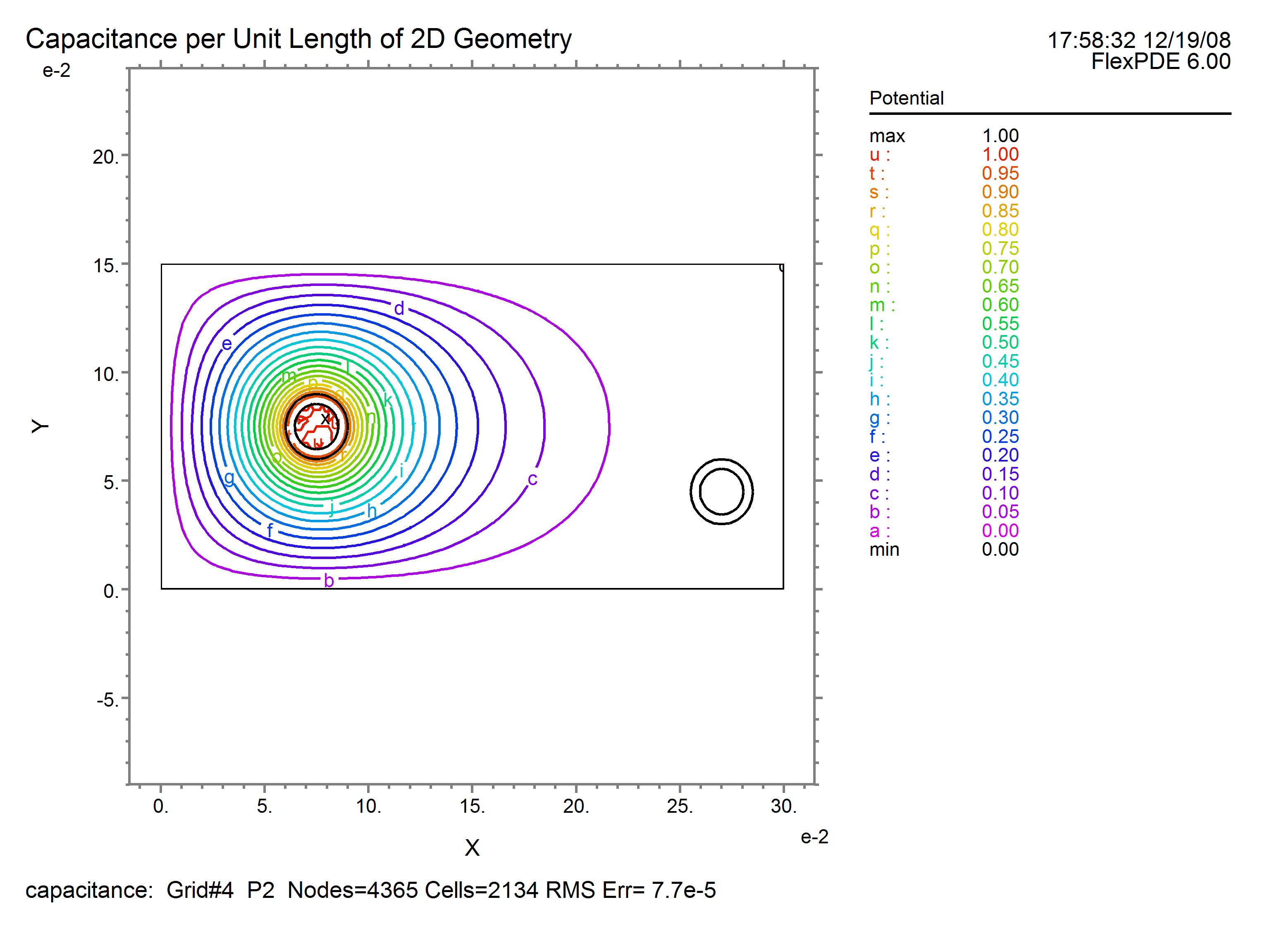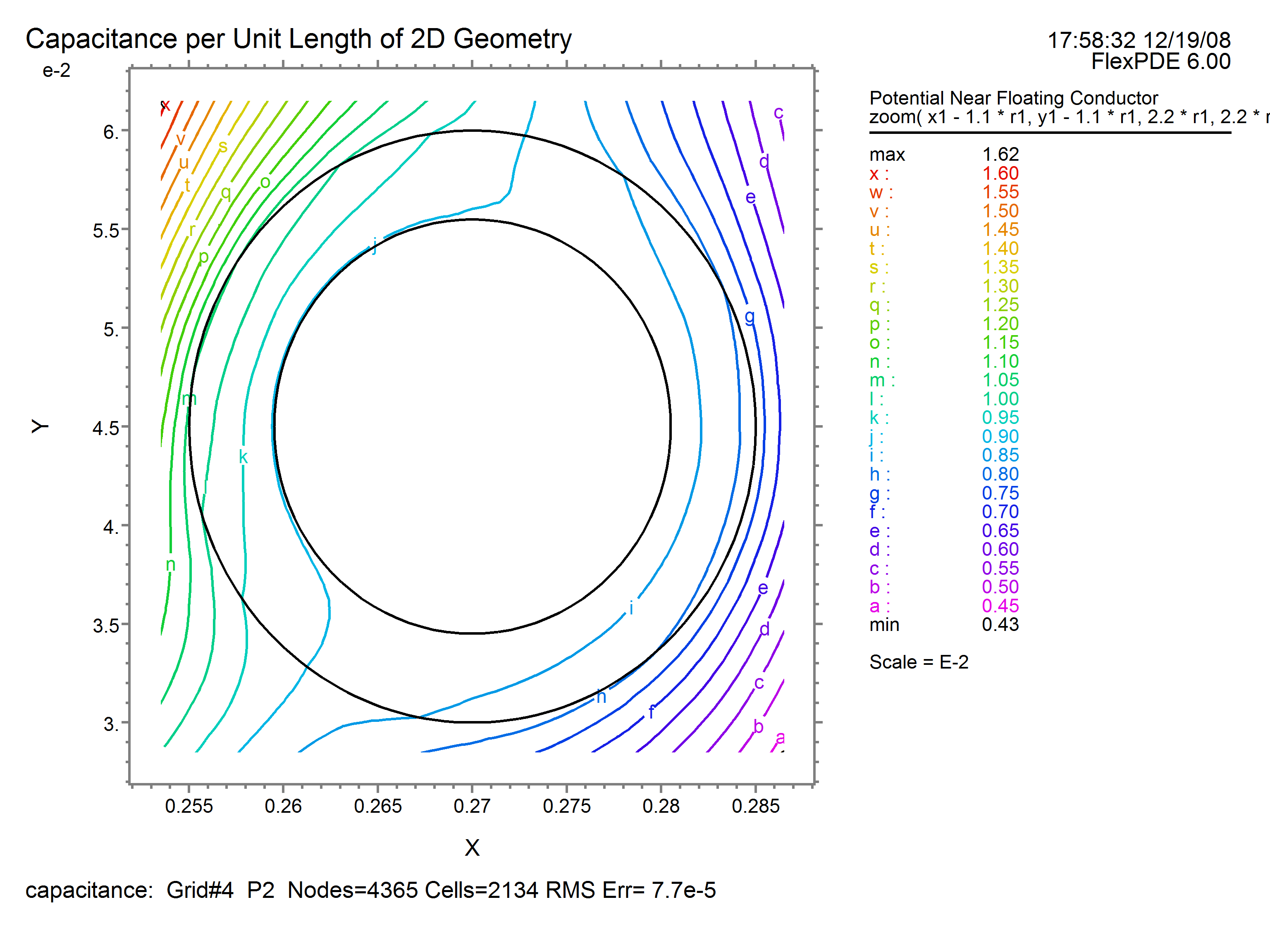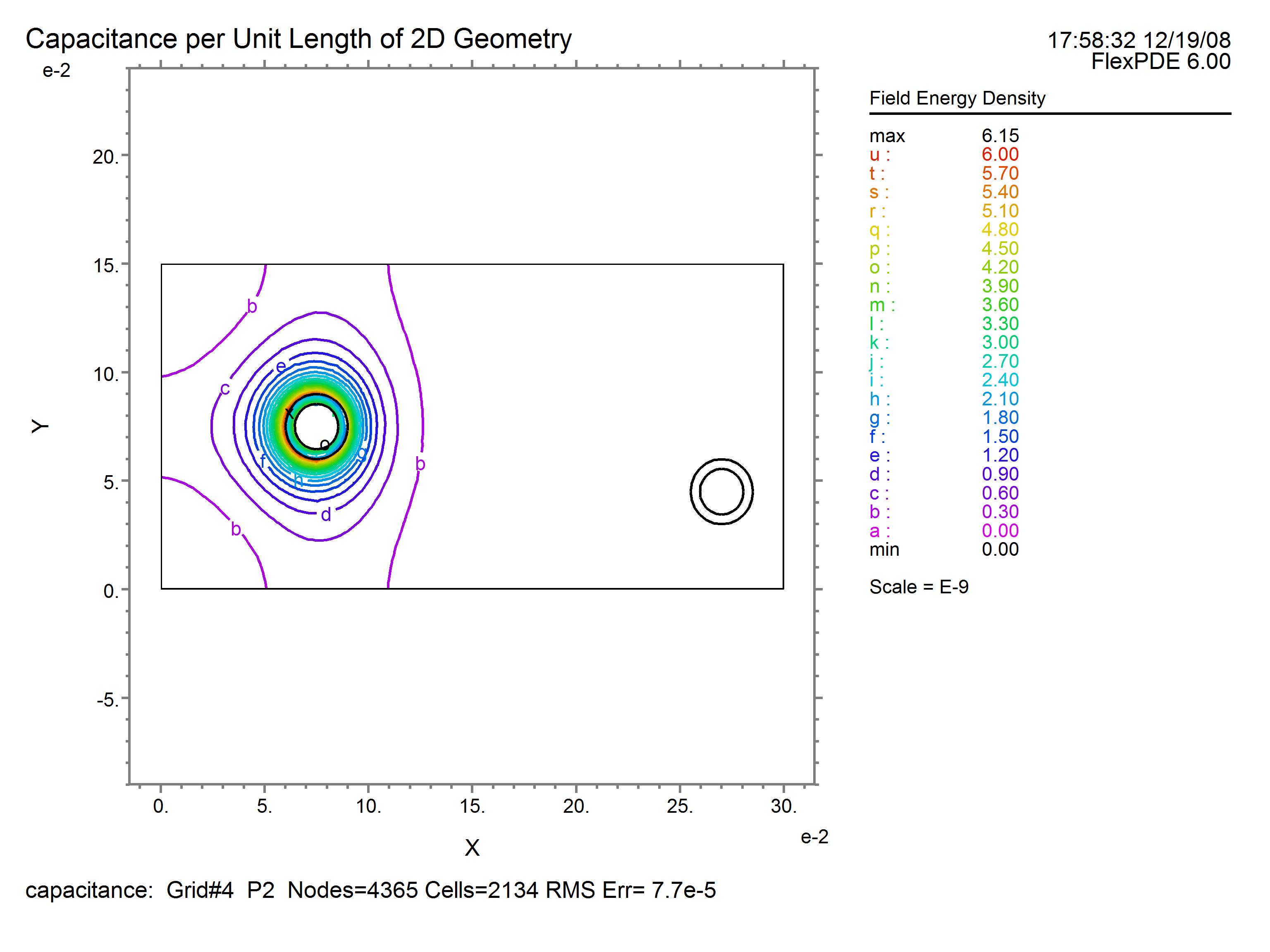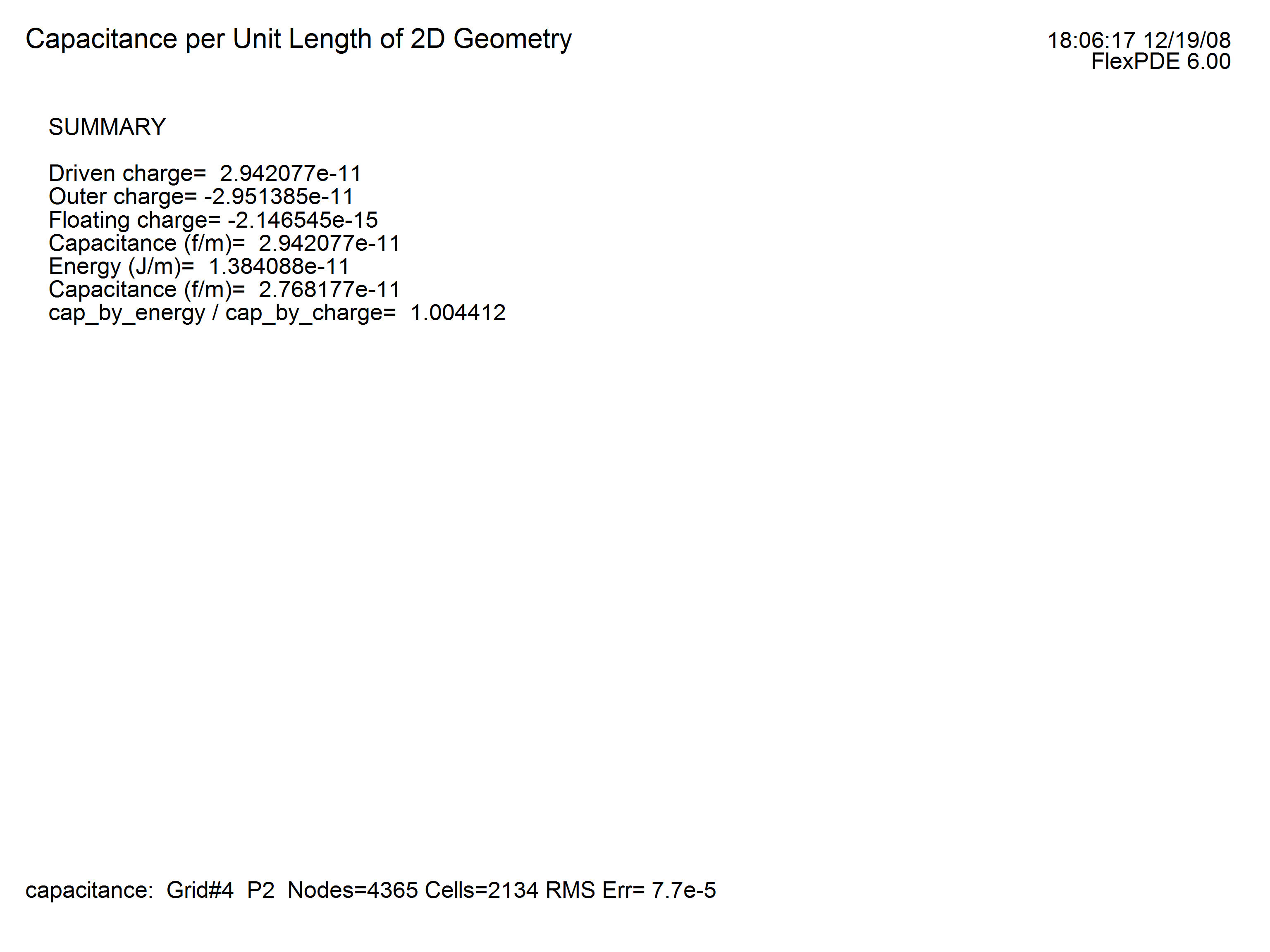|
<< Click to Display Table of Contents >> Capacitance per Unit Length in 2D Geometry |
  
|
|
<< Click to Display Table of Contents >> Capacitance per Unit Length in 2D Geometry |
  
|
- Submitted by J.B. Trenholme
This problem illustrates the calculation of capacitance per unit length in a 2D X-Y geometry extended indefinitely in the Z direction. The capacitance is that between a conductor enclosed in a dielectric sheath and a surrounding conductive enclosure. In addition to these elements, there is also another conductor (also with a dielectric sheath) that is "free floating" so that it maintains zero net charge and assumes a potential that is consistent with that uncharged state.
We use the potential ![]() as the system variable, from which we can calculate the electric field
as the system variable, from which we can calculate the electric field![]() and displacement
and displacement ![]() , where
, where ![]() is the local permittivity and may vary with position.
is the local permittivity and may vary with position.
In steady state, in charge-free regions, Maxwell’s equation then becomes
![]() .
.
We impose value boundary conditions on ![]() at the surfaces of the two conductors, so that we do not have to deal with regions that contain charge.
at the surfaces of the two conductors, so that we do not have to deal with regions that contain charge.
The metal in the floating conductor is "faked" with a fairly high permittivity, which has the effect of driving the interior field and field energy to near zero. The imposition of (default) natural boundary conditions then keeps the field normal to the surface of the conductor, as Maxwell requires. Thus we get a good answer without having to solve for the charge on the floating conductor, which would be a real pain due to its localization on the surface of the conductor.
The capacitance can be found in two ways. If we know the charge ![]() on the conductor at fixed potential
on the conductor at fixed potential ![]() , we solve
, we solve
![]() to get
to get![]() . We know
. We know ![]() because it is imposed as a boundary condition, and we can find
because it is imposed as a boundary condition, and we can find ![]() from the fact that
from the fact that ![]() , where the integral is taken over a surface enclosing a volume and
, where the integral is taken over a surface enclosing a volume and ![]() is the total charge in the volume.
is the total charge in the volume.
Alternatively, we can use the energy relation ![]() to get
to get ![]() . We find the energy
. We find the energy ![]() by integrating the energy density
by integrating the energy density ![]() over the area of the problem.
over the area of the problem.
See also "Samples | Applications | Electricity | Capacitance.pde"
TITLE 'Capacitance per Unit Length of 2D Geometry'
{ 17 Nov 2000 by John Trenholme }
SELECT
errlim 1e-4
thermal_colors on
plotintegrate off
VARIABLES
V
DEFINITIONS
mm = 0.001 ! meters per millimeter
Lx = 300 * mm ! enclosing box dimensions
Ly = 150 * mm
b = 0.7 ! fractional radius of conductor
! position and size of cable at fixed potential:
x0 = 0.25 * Lx
y0 = 0.5 * Ly
r0 = 15 * mm
x1 = 0.9 * Lx
y1 = 0.3 * Ly
r1 = r0
epsr ! relative permittivity
epsd = 3 ! epsr of cable dielectric
epsmetal = 1000 ! fake metallic conductor
eps0 = 8.854e-12 ! permittivity of free space
eps = epsr * eps0
v0 = 1 ! fixed potential of the cable
! field energy density:
energyDensity = dot( eps * grad( v), grad( v) )/2
EQUATIONS
div( eps * grad( v) ) = 0
BOUNDARIES
region 1 'inside' epsr = 1
start 'outer' ( 0, 0) value( v) = 0
line to (Lx,0) to (Lx,Ly) to (0,Ly) to close
region 2 'diel0' epsr = epsd
start 'dieb0' (x0+r0, y0)
arc ( center = x0, y0) angle = 360
region 3 'cond0' epsr = 1
start 'conb0' (x0+b*r0, y0) value(v) = v0
arc ( center = x0, y0) angle = 360
region 4 'diel1' epsr = epsd
start 'dieb1' ( x1+r1, y1)
arc ( center = x1, y1) angle = 360
region 5 'cond1' epsr = epsmetal
start 'conb1' ( x1+b*r1, y1)
arc ( center = x1, y1) angle = 360
PLOTS
contour( v) as 'Potential'
contour( v) as 'Potential Near Driven Conductor'
zoom(x0-1.1*r0, y0-1.1*r0, 2.2*r0, 2.2*r0)
contour( v) as 'Potential Near Floating Conductor'
zoom(x1-1.1*r1, y1-1.1*r1, 2.2*r1, 2.2*r1)
elevation( v) from ( 0,y0) to ( x0, y0)
as 'Potential from Wall to Driven Conductor'
elevation( v) from ( x0, y0) to ( x1, y1)
as 'Potential from Driven to Floating Conductor'
vector( grad( v)) as 'Field'
contour( energyDensity) as 'Field Energy Density'
contour( energyDensity)
zoom( x1-1.2*r1, y1-1.2*r1, 2.4*r1, 2.4*r1)
as 'Field Energy Density Near Floating Conductor'
elevation( energyDensity)
from (x1-2*r1, y1) to ( x1+2*r1, y1)
as 'Field Energy Density Near Floating Conductor'
contour( epsr) paint on "inside"
as 'Definition of Inside'
SUMMARY
report sintegral(normal(eps*grad(v)),'conb0', 'diel0')
as 'Driven charge'
report sintegral(normal(eps*grad(v)),'outer','inside')
as 'Outer charge'
report sintegral(normal(eps*grad(v)),'conb1','diel1')
as 'Floating charge'
report sintegral(normal(eps*grad(v)),'conb0','diel0')/v0
as 'Capacitance (f/m)'
report integral( energyDensity, 'inside')
as 'Energy (J/m)'
report 2 * integral( energyDensity, 'inside') / v0^2
as 'Capacitance (f/m)'
report 2 * integral(energyDensity)/(v0*
sintegral( normal(eps*grad(v)), 'conb0', 'diel0'))
as 'cap_by_energy / cap_by_charge'
END



